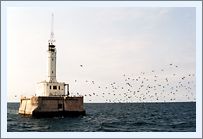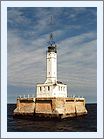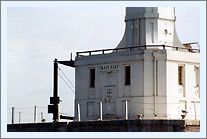|
Historical
Information

Grays Reef Passage serves as
the primary route between the Straits and the ports on the southern
shores of Lake Michigan. Bounded on the east by Vienna Shoal and East
Shoal, Grays Reef itself forms the western boundary of the passage, and
consists of an extensive area of shallow water over a rocky bottom
stretching over eight miles in length. With some portions of its rocky
bottom almost protruding above the water’s surface, the reef has long
represented a significant threat to any vessel master unfamiliar with
the intricacies of the passage.
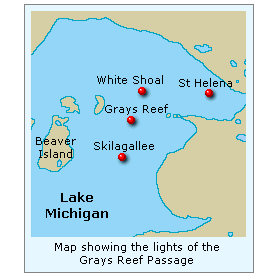 As traffic
through the Straits burgeoned with increasing shipments of iron ore out
of Lake Superior through the 1880’s, mariners began lobbying the
Lighthouse Board to improve the lighting of a number of dangerous shoals
in the Straits area. While the construction of manned light stations in
such locations was preferred, the high costs associated with offshore
construction made the anchoring of lightships over such obstructions a
significantly more expeditious and cost effective solution. Responding
to this need, the Lighthouse Board requested Congressional funding for
the construction of three such vessels in the late 1880’s for
deployment on White Shoal, Simmons Reef and Grays Reef. As traffic
through the Straits burgeoned with increasing shipments of iron ore out
of Lake Superior through the 1880’s, mariners began lobbying the
Lighthouse Board to improve the lighting of a number of dangerous shoals
in the Straits area. While the construction of manned light stations in
such locations was preferred, the high costs associated with offshore
construction made the anchoring of lightships over such obstructions a
significantly more expeditious and cost effective solution. Responding
to this need, the Lighthouse Board requested Congressional funding for
the construction of three such vessels in the late 1880’s for
deployment on White Shoal, Simmons Reef and Grays Reef.
Congress responded on March 2, 1899 with an appropriation of $60,000.
The Board submitted requests for quotation to a number of shipbuilders,
with the contract ultimately awarded to the Blythe Craig Shipbuilding Co
of Toledo, Ohio. Plans for the three identical 103-foot oak-planked
vessels called for them to be equipped with a single screw driven by a
small single cylinder steam engine. These engines were designed to
provide the vessels with sufficient power to allow them to get on and
off station under their own power. Thereby eliminating the costs
associated with having a lighthouse tender moving them on and off
station at the beginning and end of the navigation season.
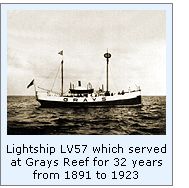 Work on the
vessels was completed on September 15, 1891, and on delivery at the
Detroit lighthouse depot they were officially designated with hull
numbers LV55, LV56 and LV57. The three vessels departed the Lighthouse
Depot under their own steam on October 19, and reaching Port Huron that
same evening, were met by the lighthouse tender DAHLIA, which towed them
north through Lake Huron and placed all three vessels on their stations
on October 24th ,1891. Work on the
vessels was completed on September 15, 1891, and on delivery at the
Detroit lighthouse depot they were officially designated with hull
numbers LV55, LV56 and LV57. The three vessels departed the Lighthouse
Depot under their own steam on October 19, and reaching Port Huron that
same evening, were met by the lighthouse tender DAHLIA, which towed them
north through Lake Huron and placed all three vessels on their stations
on October 24th ,1891.
With the exception of spending winters in Cheboygan Harbor, where she
underwent annual maintenance during the annual ice-over, LV57 served on
Grays Reef every shipping season for the following thirty-two years
until her hull was found to be rotted beyond repair at winter lay-up in
1923, and she was immediately removed from service.
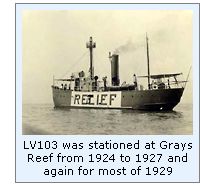 To replace the
retiring vessel, LV103 was temporarily placed in Grays Reef at the
opening of the 1924 navigation season. Built by the Consolidated
Shipbuilding Corporation of Morris Heights New York, LV103 had been
delivered to the District headquarters in Milwaukee on June, 1921, and
had spent the past three years serving as a relief vessel throughout
Lake Michigan. To replace the
retiring vessel, LV103 was temporarily placed in Grays Reef at the
opening of the 1924 navigation season. Built by the Consolidated
Shipbuilding Corporation of Morris Heights New York, LV103 had been
delivered to the District headquarters in Milwaukee on June, 1921, and
had spent the past three years serving as a relief vessel throughout
Lake Michigan.
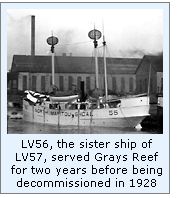 LV103 remained
at Grays Reef until 1927, when LV56 was transferred-in on the opening of
the navigation season. One of the two sister ships to LV56, from all
appearances she had weathered the rigors of work on the lake better than
her sister, and was still considered to be in serviceable condition.
After commissioning in 1891, she had served at White Shoal until 1909,
when she was reassigned to North Manitou Shoal after completion of
construction of the White Shoal Light. However, the outward appearances
of her seaworthiness were evidently misleading, as she too was found to
be suffering from a considerable amount of hull deterioration, and was
declared unseaworthy during her 1928-1929 winter lay-up in Cheboygan,
and she too was removed from service. LV103 remained
at Grays Reef until 1927, when LV56 was transferred-in on the opening of
the navigation season. One of the two sister ships to LV56, from all
appearances she had weathered the rigors of work on the lake better than
her sister, and was still considered to be in serviceable condition.
After commissioning in 1891, she had served at White Shoal until 1909,
when she was reassigned to North Manitou Shoal after completion of
construction of the White Shoal Light. However, the outward appearances
of her seaworthiness were evidently misleading, as she too was found to
be suffering from a considerable amount of hull deterioration, and was
declared unseaworthy during her 1928-1929 winter lay-up in Cheboygan,
and she too was removed from service.
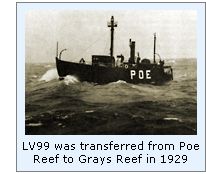 With
construction of the new light at Poe Reef well underway, plans were put
in place to relocate LV99 from Poe to Grays Reef upon the light station’s
completion the following summer. Thus relief vessel LV103 was once again
temporarily stationed at Grays Reef at the beginning of the 1929
shipping season until she was replaced by LV99 that fall. LV99 was one
of the newest of the Great Lakes lightships, and represented the current
state of the art. Built in 1920 by Rice Brothers at Boothbay Harbor in
Maine, she was steel-hulled, 92-feet in length, and was equipped with a
single acetylene powered light, a ten-inch steam fog whistle and a
submarine bell, which had been added to her arsenal of warning equipment
in 1923. With
construction of the new light at Poe Reef well underway, plans were put
in place to relocate LV99 from Poe to Grays Reef upon the light station’s
completion the following summer. Thus relief vessel LV103 was once again
temporarily stationed at Grays Reef at the beginning of the 1929
shipping season until she was replaced by LV99 that fall. LV99 was one
of the newest of the Great Lakes lightships, and represented the current
state of the art. Built in 1920 by Rice Brothers at Boothbay Harbor in
Maine, she was steel-hulled, 92-feet in length, and was equipped with a
single acetylene powered light, a ten-inch steam fog whistle and a
submarine bell, which had been added to her arsenal of warning equipment
in 1923.
Since the construction of the first 350-foot long lock at the Soo in
1855, the size of the locks had served as the limiting factor for the
length of commercial vessels able to move through them in and out of
Lake Superior. Since larger vessels allowed larger loads, while still
allowing for the same number of trips during the navigation season, ship
owners were constantly clamoring for the construction of larger locks at
the Soo, and a thirty year cycle of lock replacement began. With the
opening of the twin 850-foot long Davis and Sabin locks in 1919, vessels
quickly grew to previously unimagined dimensions, and the Army Corps of
Engineers was pressed to ensure that all navigation channels throughout
the lakes were improved to handle longer and deeper draft vessels.
With many of the largest ore-carrying vessels making their way
through Grays Reef Passage on their down-bound trip to the steel mills
of southern Lake Michigan, the US Army Corps of Engineers were working
in the Passage in the early 1930’s taking soundings in preparation to
enlarging the two mile long passage to a width of 3,000 feet and a
minimum depth of 25 feet, opening it up to the largest vessels of the
time.
As a result of improvements in offshore construction learned in the
construction of the Lake Huron stations at Poe Reef, Martin Reef and
Fourteen foot Shoal in the late 1920’s, the technology was in place
and the time was right to finally replace the lightship on Grays Reef
with a first class light station to guide mariners through the passage.
After consulting with the Army Corps of Engineers and the Lake Carrier’s
Association, the Lighthouse Service determined that the optimum location
for the new station would be in 26 feet of water, 100 feet off a turn in
the proposed channel, and slightly to the southeast of the existing
lightship anchorage.
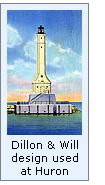 Funding for the new station was approved by Congress on February 14,
1934, and plans and specifications were drawn up soon thereafter. The
design of the steel lighthouse structure was a modification and
enlargement of the F. P. Dillon and W. G. Will design being used for breakwater
lights at Conneaut and Huron, and was an exact twin a new station to be
established at Minneapolis Shoal. Bids for construction were advertised
with a stipulated completion date of by July 1, 1936. The contract for
the station’s construction was finally awarded to the Greiling
Brothers Company, who had considerable experience in water-based
construction including the erection of the breakwaters at Ludington and
a large dock at Rogers City. Funding for the new station was approved by Congress on February 14,
1934, and plans and specifications were drawn up soon thereafter. The
design of the steel lighthouse structure was a modification and
enlargement of the F. P. Dillon and W. G. Will design being used for breakwater
lights at Conneaut and Huron, and was an exact twin a new station to be
established at Minneapolis Shoal. Bids for construction were advertised
with a stipulated completion date of by July 1, 1936. The contract for
the station’s construction was finally awarded to the Greiling
Brothers Company, who had considerable experience in water-based
construction including the erection of the breakwaters at Ludington and
a large dock at Rogers City.
Under the supervision of Chester Greiling, work began on shore at St.
Ignace in the summer of 1934 with the construction of a 65-foot square
timber crib, which would form a foundation for the concrete pier on
which the station would be erected. Built of 12" by 12"
timbers, internal cross-timbers divided the inner section of the crib
into 49 pockets. On completion of the crib in September, it was
carefully floated and towed out of St. Ignace and west through the
Straits. Arriving at Grays Reef, the crib was centered on the selected
site, and the 25 inner pockets slowly filled with stone. Eventually
overcoming its natural buoyancy, the crib sank in place on the bottom.
The 25 outer pockets were then filled with concrete, and forms erected
for the pouring of a six-foot thick concrete floor and walls. Work
continued through the fall of 1934 until the onset of winter made
conditions too dangerous, and work was ended until the opening of the
1935 navigation season
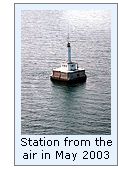 By June 1935, the temporary stone had been removed from the center
pockets and refilled with concrete. Forms were installed, spanning
across the walls and a steel reinforced concrete floor, one foot thick
poured to create the pier deck. The center section of the pier between
the six-foot thick walls was left open to form two-story mechanical
room. The lighthouse building itself was to stand 30-feet square and 15
feet tall, and consisted of a structural steel girder framework over
which walls of sheet steel were to be riveted in place. Much of the
steel framework was pre-assembled in St. Ignace and loaded on the
Greiling boat RAMBLER, and then hoisted onto the pier at the reef for
erection. By the end of 1935, work on the concrete pier and steel
framework was both complete, when the work was again suspended with the
arrival of winter By June 1935, the temporary stone had been removed from the center
pockets and refilled with concrete. Forms were installed, spanning
across the walls and a steel reinforced concrete floor, one foot thick
poured to create the pier deck. The center section of the pier between
the six-foot thick walls was left open to form two-story mechanical
room. The lighthouse building itself was to stand 30-feet square and 15
feet tall, and consisted of a structural steel girder framework over
which walls of sheet steel were to be riveted in place. Much of the
steel framework was pre-assembled in St. Ignace and loaded on the
Greiling boat RAMBLER, and then hoisted onto the pier at the reef for
erection. By the end of 1935, work on the concrete pier and steel
framework was both complete, when the work was again suspended with the
arrival of winter
With the arrival of Greiling and his crew in 1936, the skinning of
the main building and tower was underway, and the inner walls lined with
concrete block to both prevent condensation and provide insulation for
the living quarters within. The mechanical room in the cellar extended
up into the first floor of the building, and housed diesel powered
generators to provide electrical power for the light and dwelling,
compressors to power the Type F diaphone fog signal, and boilers for the
hot water central heating system. The second floor made up the keepers
quarters, and was replete with electric lighting and sanitary plumbing.
Centered atop the main building, the 17-foot tall tower stood 16-feet
square at the base, and after a graceful rolled flare, narrowed to
10-feet square beneath the gallery.
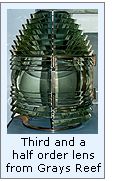 The tower was topped by a circular lantern with helical astragals,
and outfitted with an occulting red Third and a Half Order Fresnel lens.
Illuminated by a 13,000 candlepower incandescent electric bulb, the bulb
was outfitted with an automatic flasher mechanism with caused it to
exhibit a repeated characteristic 4 seconds of light followed by 2
seconds of darkness. Seated at a focal plane of 82 feet, the light was
visible for a distance of 17 miles in clear weather conditions. The tower was topped by a circular lantern with helical astragals,
and outfitted with an occulting red Third and a Half Order Fresnel lens.
Illuminated by a 13,000 candlepower incandescent electric bulb, the bulb
was outfitted with an automatic flasher mechanism with caused it to
exhibit a repeated characteristic 4 seconds of light followed by 2
seconds of darkness. Seated at a focal plane of 82 feet, the light was
visible for a distance of 17 miles in clear weather conditions.
Greiling finished work on the station in September of 1936, two
months behind the stipulated date, and considerably over budget. With
the activation of the new light, LV99 was removed from her anchorage,
the last in a long line of stalwart lightships to serve mariners in Lake
Michigan’s treacherous northern waters.
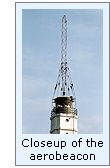 On May 3, 1937, a radio beacons was installed at the station, and its
signal exactly synchronized with the diaphone fog signal. This
synchronization allowed mariners to precisely calculate their distance
from the station by measuring the time differential between receiving
the radio signal and hearing the diaphone. With responsibility for the
nation’s aids to navigation transferred to the Coast Guard in 1939,
Coast Guard crews began manning the station as the civilian Lighthouse
Service keepers retired. On May 3, 1937, a radio beacons was installed at the station, and its
signal exactly synchronized with the diaphone fog signal. This
synchronization allowed mariners to precisely calculate their distance
from the station by measuring the time differential between receiving
the radio signal and hearing the diaphone. With responsibility for the
nation’s aids to navigation transferred to the Coast Guard in 1939,
Coast Guard crews began manning the station as the civilian Lighthouse
Service keepers retired.
Advances in solar-powered systems in the 1970’s facilitated the
automation of an increasing number of offshore lights, and the
elimination of the high costs associated with keeping five-man crews
supplied throughout the navigation season. Thus, in 1976 the lights at
White Shoal, Lansing Shoal and Grays Reef were all automated, and the
last crew to serve at the Grays Reef was removed.
Today, Grays Reef’s light is provided by a 190 mm 12-volt dc
solar-powered acrylic Tidelands Signal optic. Power generated by the
photovoltaic panel during daylight hours is stored in a series of
batteries for use at night, when the stations flashing red light still
shines 15 miles across the lake to warn mariners of the western limit of
the passage.
The station now sits empty with the exception of infrequent visits by
Coast Guard crews to conduct standard maintenance on the lighting
system. The station is also "manned" for a couple of days
every July, when with the permission of the Coast Guard, officials of
the Chicago Yacht club use the station as an observation platform to
monitor contestants making their way through Grays Reef passage during
the annual Chicago to Mackinac yacht race.

Keepers of this Light

Click
Here to see a complete listing of all Grays Reef Light keepers
compiled by Phyllis L. Tag of Great Lakes Lighthouse Research.

Seeing this Light

Sheplers Ferry Service out of Mackinaw City
offers a number of lighthouse cruises during the summer season. Their
"Westward Tour" includes passes by White Shoal, Grays Reef,
Waugoshance and St. Helena Island. For schedules and rates for this
tour, visit their website at: www.sheplerswww.com
or contact them at:
PO Box 250
Mackinaw City, MI 49701
Phone (800) 828-6157

Reference Sources

Annual reports of the Lighthouse
Board, various, 1869 – 1910
Annual reports of the Lighthouse Service, 1911 – 1938
Great Lakes Light Lists, various, 1939 – 1977
Grays Grief, Michigan History magazine, Saralee R. Howard-Filler,
Sept/Oct 1986
Last Lakes lighthouse crew departs, Detroit News, October 7, 1976
Great Lakes Lightships – Shoal Assignments, Terry Pepper, 2000
Great Lakes Pilot, US Army Corps of Engineers, 1958
Annual reports of the Great Lakes Carriers Association, various,
1914 - 1937
Lightships and Lightship Stations of the United States Government,
Willard Flint, 1989
The Long Ships Passing, Walter Havighurst,
1943
Keeper listings for this light appear courtesy of Great
Lakes Lighthouse Research
|
